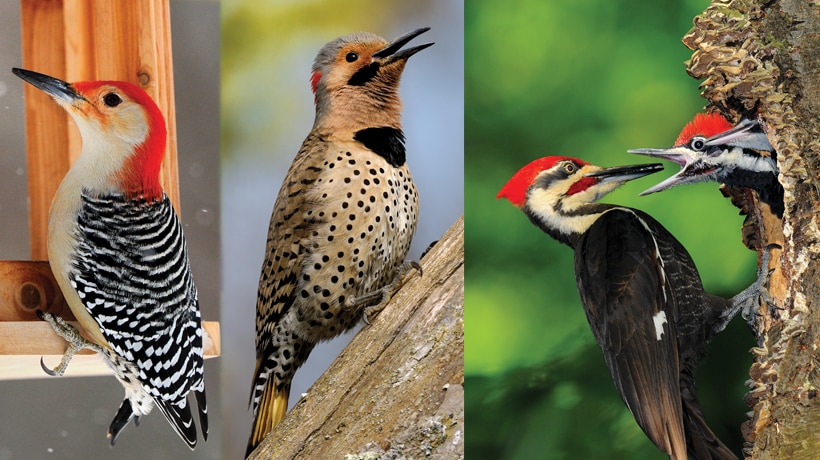Observing Woodpeckers in Florida: Variety Diversity and Circulation
Observing Woodpeckers in Florida: Variety Diversity and Circulation
Blog Article
Woodpeckers Unleashed: Exploring the Wonders of These Skilled Tree Mountain Climbers
Woodpeckers, with their distinct markings and rhythmic drumming echoing via wooded areas, hold an unique location in the avian globe. Their specialized anatomy and adjustments enable them to browse vertical surface areas with exceptional ability. Their proficiency of tree climbing is simply one element of their remarkable behavior. As we dive into the complex details of woodpeckers' nesting routines, feeding techniques, and the continuous preservation efforts to secure these remarkable birds, a much deeper appreciation for their location in nature unravels.
Makeup and Adaptations
When checking out the anatomy and adjustments of woodpeckers, one can observe amazing functions that make it possible for these birds to prosper in their specialized ecological niche. Woodpeckers are furnished with a collection of one-of-a-kind physiological qualities that help them in their woodpecking habits. Among one of the most noticeable features is their strong, chisel-like beak, which is specialized for drilling into wood to uncover insects or create nesting tooth cavities. This beak is supported by strong neck muscle mass and an extremely established skull structure that serves as a shock absorber, enabling woodpeckers to continuously eat trees without triggering mind injury. In addition, woodpeckers have zygodactyl feet, with 2 toes dealing with ahead and two dealing with backwards, supplying a company hold on tree trunks while they look for food or drum for communication.
In addition, woodpeckers have an one-of-a-kind tongue framework that is long, barbed, and sticky, enabling them to extract pests from crevices in wood. This specialized adaptation allows woodpeckers to make use of a food source that is hard to reach to lots of other bird species. On the whole, the composition and adaptations of woodpeckers showcase the impressive transformative services that have actually enabled these birds to thrive in their arboreal environment.
Drumming Habits
Having actually checked out the anatomy and adjustments of woodpeckers, the focus currently shifts to recognizing their drumming habits, a distinct element of their interaction and territorial screens. Drumming is a vital kind of communication amongst woodpeckers, offering several objectives such as establishing regions, attracting friends, and signaling alarm. Each woodpecker types has an unique drumming pattern that aids individuals acknowledge participants of their own types and identify them from competitors or killers.
Woodpeckers produce drumming sounds by rapidly pecking on resonant surface areas such as dead trees, energy poles, and even steel things, producing a collection of balanced beats. The strength and rate of drumming can vary based on the purpose; for instance, a fast drumming series might symbolize hostility in the direction of intruders, while a slower and softer drumming pattern might show courtship (Woodpeckers in Florida). Additionally, woodpeckers may adjust the frequency and period of their drumming to share certain messages efficiently
Nesting Habits
Checking out the nesting habits of woodpeckers exposes interesting insights into their reproductive behaviors and habitat choices. Woodpeckers are understood for their one-of-a-kind nesting preferences, commonly digging deep into dental caries in trees to create sheltered spaces for raising their young. These tooth cavities offer not just as a nesting website but additionally as a secure haven from predators and harsh weather condition.
Woodpeckers display a high degree of integrity to their nesting websites, usually going back to the very same area time after time. This actions highlights the relevance of ideal environment accessibility for their reproductive success. The choice of a nesting site is important for woodpeckers, with elements such as tree species, height, and degeneration phase playing considerable functions in their decision-making process.
Interestingly, some woodpecker varieties are recognized to dig deep browse around these guys into several cavities within their territory, providing themselves with alternate nesting choices. This strategy might act as a type of insurance coverage against potential hazards or disruptions to their primary nesting website.

Feeding Methods
Woodpeckers use a variety of specialized feeding methods to obtain their key food sources. One of the most unique feeding actions of woodpeckers is drumming, which involves rapid pecking on trees to discover bugs under the bark. This drumming not just helps them find victim but additionally here are the findings serves as a way of communication with various other woodpeckers. Woodpeckers have strong, chisel-like beaks that allow them to pierce into wood easily. When a hole is produced, they utilize their lengthy, barbed tongues to remove insects such as ants, beetles, larvae, and crawlers. These tongues are coated with sticky saliva that assists trap the victim. Woodpeckers are likewise understood to dig deep into tooth cavities in trees to access covert insect larvae or sap. Some types, like the acorn woodpecker, store nuts in specifically produced holes called granaries. This calculated saving of food assists them make it through throughout food shortage periods. Woodpeckers are genuinely exceptional in their feeding methods, showcasing versatility and intelligence in procuring their nutrition.
Conservation Initiatives
Amidst the detailed feeding strategies displayed by woodpeckers, the conservation initiatives intended at protecting these fascinating birds play a critical function in protecting their environments and populaces. Woodpeckers deal with various hazards to go to this site their survival, including habitat loss as a result of deforestation, environment modification altering their ecosystems, and crashes with synthetic structures such as structures and automobiles - Woodpeckers in Florida. Guardians are actively functioning to attend to these challenges and make sure the lasting health of woodpecker types

Education and learning and public understanding campaigns are additionally crucial elements of woodpecker conservation initiatives. By increasing awareness concerning the significance of these birds in maintaining healthy and balanced forest ecosystems, preservationists can amass support for environment conservation initiatives and advertise responsible land monitoring methods. Via collective efforts in between researchers, policymakers, and regional communities, we can collaborate to safeguard a future where woodpeckers grow in their all-natural habitats.
Verdict

Report this page